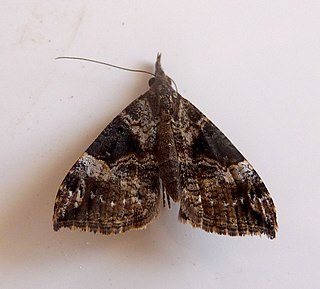
The minor shoulder-knot is a moth of the family Noctuidae. The species was first described by Johan Christian Fabricius in 1776. It is distributed throughout Europe then east across the Palearctic to Siberia and Japan. It also occurs in Turkey.

Apamea crenata, known as the clouded-bordered brindle, is a moth in the family Noctuidae. It is distributed throughout the Palearctic realm. In the North it crosses the Arctic Circle, in the Mediterranean it is found only in cool locations and mountains avoiding very hot areas. In the Alps, it rises to an altitude of about 2000 metres.

Protodeltote pygarga, the marbled white spot, is a species of moth of the family Noctuidae. It is found in the Palearctic realm.

Anaplectoides prasina is a species of moth of the family Noctuidae. It is found in both the Palearctic and Nearctic realms.

Synthymia is a genus of moths of the family Noctuidae. It contains only one species, Synthymia fixa, The Goldwing, which is found in southern Europe and North Africa.

Mesapamea secalis, the common rustic, is a moth of the family Noctuidae. The species was first described by Carl Linnaeus in his 1758 10th edition of Systema Naturae. It is found in Europe, north-west Africa, Turkey and northern Iran.

Hypena obsitalis, the Bloxworth snout, is a moth of the family Erebidae. It is found in the Mediterranean Basin including North Africa and in the Near East and Middle East, south up to the Sahara. Further north it is a migrant which occasionally establishes.
Battaristis amphiscolia is a moth of the family Gelechiidae. It was described by Edward Meyrick in 1914. It is found in Guyana.
Battaristis ardiophora is a moth of the family Gelechiidae. It was described by Edward Meyrick in 1914. It is found in Guyana, Brazil and Peru.
Battaristis ichnota is a moth of the family Gelechiidae. It was described by Edward Meyrick in 1914. It is found in Guyana.
Battaristis orthocampta is a moth of the family Gelechiidae. It was described by Edward Meyrick in 1914. It is found in Guyana.
Battaristis prismatopa is a moth of the family Gelechiidae. It was described by Edward Meyrick in 1914. It is found in Guyana.
Battaristis stereogramma is a moth of the family Gelechiidae. It was described by Edward Meyrick in 1914. It is found in Guyana.
Battaristis coniosema is a moth of the family Gelechiidae. It was described by Edward Meyrick in 1922. It is found in Peru and Pará, Brazil.
Battaristis bistrigella is a moth of the family Gelechiidae. It was described by August Busck in 1914. It is found in Panama.
Battaristis unistrigella is a moth of the family Gelechiidae. It was described by August Busck in 1914. It is found in Panama.
Battaristis cyclella is a moth of the family Gelechiidae. It was described by August Busck in 1903. It is found in North America, where it has been recorded from Arizona and Utah.
Battaristis emissurella is a moth of the family Gelechiidae. It was described by Francis Walker in 1864. It is found in Panama, Colombia, Suriname, Guyana and Brazil.
Battaristis perinaeta is a moth of the family Gelechiidae. It was described by Walsingham in 1910. It is found in Mexico (Guerrero).
Psittacastis incisa is a moth in the family Depressariidae. It was described by Lord Walsingham in 1912. It is found in Mexico (Tabasco) and Panama.






